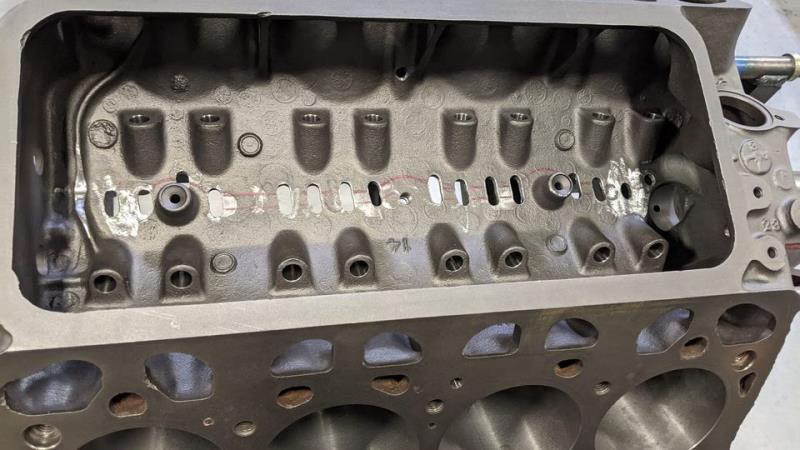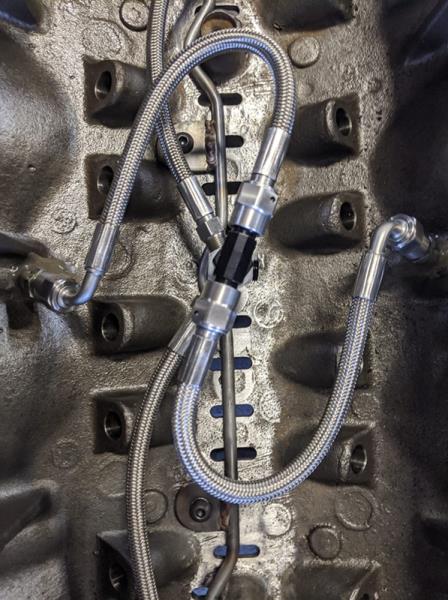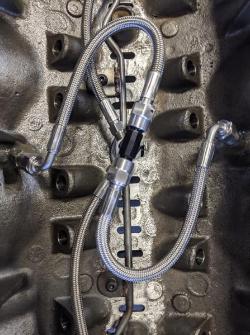|
Author
|
Message
|
|
paul2748
|
|
|
Group: Forum Members
Last Active: Yesterday
Posts: 3.7K,
Visits: 497.8K
|
Seen this on another site. I guess it's to get the oil down to the pan quicker or lube the cam better. Weaken the block??  54 Victoria 312; 48 Ford Conv 302, 56 Bird 312
54 Victoria 312; 48 Ford Conv 302, 56 Bird 312
Forever Ford
Midland Park, NJ
|
|
|
|
|
Joe-JDC
|
|
|
Group: Forum Members
Last Active: Yesterday
Posts: 772,
Visits: 22.6K
|
Just my opinion, but on my blocks, we drilled a small 3/16" hole aimed toward the camshaft lobe on the side that keeps the oil away from the center of the engine, and creates less windage. You don't want the oil from the camshaft area to be thrown back up into the valley and create more aeration for the PCV to pick up. You need a certain amount oil to stay in the valley area to keep the lifters cool and properly rotating, as well as lubricating the pushrod ends. There is a large area at the rear of the valley for oil drain back that also keeps the distributor gear oiled. You don't want to take that away and let the distributor gear run hot. Joe-JDC
JDC
|
|
|
|
|
PF Arcand
|
|
|
Group: Forum Members
Last Active: Last Year
Posts: 3.3K,
Visits: 238.8K
|
Eickman's Y-Block book, (1984) suggests drilling & chamfering the block, but not to that extent! Holes that big likely do weaken the block. And as Joe JDC says, some oil is needed up there. It's likely those big holes result in excessive upwards oil spray.. FWIW I wouldn't do it..
Paul
|
|
|
|
|
Ted
|
|
|
Group: Administrators
Last Active: Yesterday
Posts: 7.5K,
Visits: 205.8K
|
|
|
|
|
|
charliemccraney
|
|
|
Group: Moderators
Last Active: Yesterday
Posts: 6.1K,
Visits: 443.0K
|
It looks like their inspiration may come from Keith Dorton. 
Lawrenceville, GA
|
|
|
|
|
55blacktie
|
|
|
Group: Forum Members
Last Active: 2 days ago
Posts: 1.2K,
Visits: 1.8K
|
Is the y-block oiling problem so severe that these modifications are necessary?
|
|
|
|
|
charliemccraney
|
|
|
Group: Moderators
Last Active: Yesterday
Posts: 6.1K,
Visits: 443.0K
|
What Ted outlined with the holes right down the center is probably the most that should be done. All of that extra plumbing, not necessary and more possible points of failure.
Lawrenceville, GA
|
|
|
|
|
Joe-JDC
|
|
|
Group: Forum Members
Last Active: Yesterday
Posts: 772,
Visits: 22.6K
|
No, the oiling in the Y is not that problematic with current oils. If you ever get a chance to see a V-8 engine's lower crankcase while the engine is running, you will be astonished at how much oil is being slung around by the 12 bearing edges on the crankshaft. (2 rod sides and middle/per journal). The idea is to get more of it away from the camshaft, not put more there. Getting the oil away from the crankshaft by using a deeper oil pan and scraper helps with reducing windage power losses. Jay Brown on his FE forum put a plexiglass window in his FE dyno oil pan to watch windage and oil level drop during a dyno pull. The engine sucked/whipped up 5 quarts instantly, and aerated the remaining oil and return so badly it looked like foam for several seconds after shut down. The only way to stop that was to deepen the oil pan a couple of inches so that the crankshaft didn't whip up the oil in the pan. A windage screen seems to work better than windage tray louvers, at least on the FE. Joe-JDC
JDC
|
|
|
|
|
bird55
|
|
|
Group: Forum Members
Last Active: 2 Years Ago
Posts: 1.1K,
Visits: 58.8K
|
And my understanding is that a dry-sump system accomplishes similar things as well depending on the application?
A L A N F R A K E S ~ Tulsa, OK
|
|
|
|
|
Ted
|
|
|
Group: Administrators
Last Active: Yesterday
Posts: 7.5K,
Visits: 205.8K
|
55blacktie (3/11/2022)
Is the y-block oiling problem so severe that these modifications are necessary? You gotta love it when a C H E V Y guy thinks he has the fix for what is a perceived oiling deficiency in an engine. Obviously overkill and will very likely cause more problems down the road as it ages. The oiling system for the Y is more than sufficient for the rod and main oiling as the stock oil pump was over-engineered from a standpoint of volume. The lack of oil changes and the use of poor quality oil though did bring forth some top end oiling issues on the Y engines back in their day. With several examples of +300K mile engines still on the road, the factory oiling system was more than adequate with quality oil and regular maintenance. Ford did wrestle with how to transfer the oil to the top end at the center cam bearing though as it started out as cross-drilled camshafts in 1954, switched to grooved camshafts in 1956, and then back to cross-drilled camshafts again in 1963. For today’s Y builds, the latest crop of cam bearings with a softer material and shallow grooved camshafts brings those top end oiling problems back to the forefront. There are several fixes for ensuring that the top end oiling issues do not crop up on a fresh rebuild with some of those being grooving the center cam groove deeper, using a center cam bearing with an external groove, or just machining the center cam hole in the block similar to what FoMoCo did for the top end oiling for the FE engines. Here is a link giving more information on the top end oiling issues related to the Ford Y. Y-Block Top End Oiling Woes – Eaton Balancing You gotta love it when a C H E V Y guy thinks he has the fix for what is a perceived oiling deficiency in an engine. Obviously overkill and will very likely cause more problems down the road as it ages. The oiling system for the Y is more than sufficient for the rod and main oiling as the stock oil pump was over-engineered from a standpoint of volume. The lack of oil changes and the use of poor quality oil though did bring forth some top end oiling issues on the Y engines back in their day. With several examples of +300K mile engines still on the road, the factory oiling system was more than adequate with quality oil and regular maintenance. Ford did wrestle with how to transfer the oil to the top end at the center cam bearing though as it started out as cross-drilled camshafts in 1954, switched to grooved camshafts in 1956, and then back to cross-drilled camshafts again in 1963. For today’s Y builds, the latest crop of cam bearings with a softer material and shallow grooved camshafts brings those top end oiling problems back to the forefront. There are several fixes for ensuring that the top end oiling issues do not crop up on a fresh rebuild with some of those being grooving the center cam groove deeper, using a center cam bearing with an external groove, or just machining the center cam hole in the block similar to what FoMoCo did for the top end oiling for the FE engines. Here is a link giving more information on the top end oiling issues related to the Ford Y. Y-Block Top End Oiling Woes – Eaton Balancing bird55 (3/11/2022)
And my understanding is that a dry-sump system accomplishes similar things as well depending on the application?A dry sump oil system does eliminate many of the windage problems that are related to running with a higher level of oil in a wet sump oil pan. I have a dry sump system on my Y powered roadster as the engine is mounted very low in the chassis which creates some challenges in running an oil pan with a sump that’s deep to compensate for the oil movement when both speeding up and slowing down. The oil pickup could be moved around to accommodate either acceleration or deceleration but not both due to the shallow depth of the pan. A dry sump system solves that as the oil pan can be made very shallow and essentially has no oil in it during normal running conditions. A three stage pump is used where one stage supplies oil to the engine and two stages keeps the oil pan sucked dry of oil. A plus to the dry sump system is that the amount of oil could be reduced from 9 quarts to 5 quarts of oil which allows for a quicker warm up. The dry sump oil systems do take a considerable amount of room though to accommodate both the pump, belt, hoses, and an externally mounted oil reservoir.
  Lorena, Texas (South of Waco) Lorena, Texas (South of Waco)
|
|
|
|